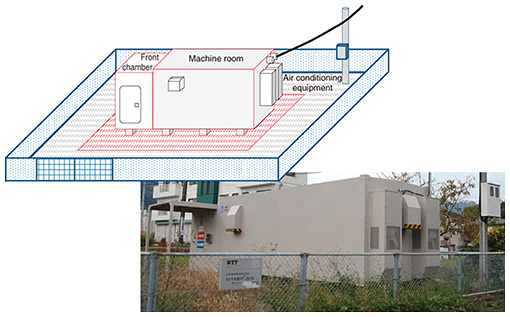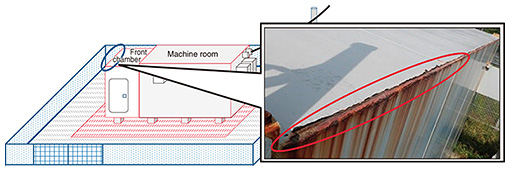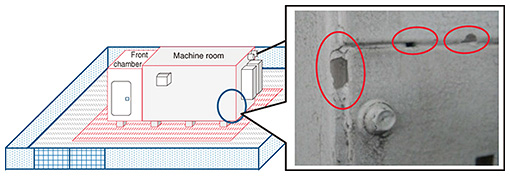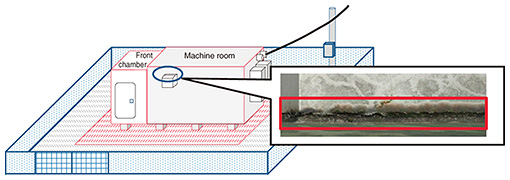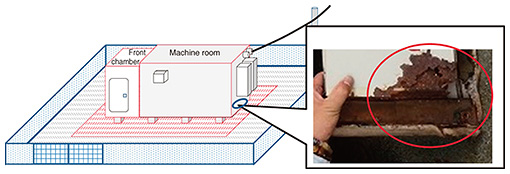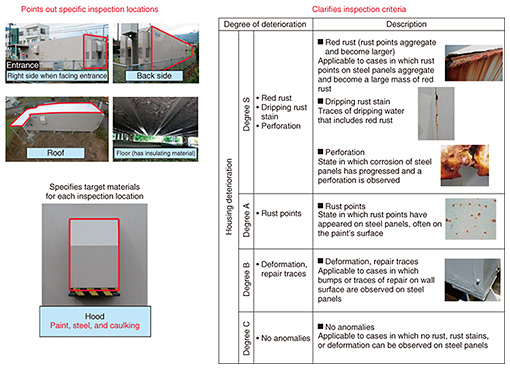 |
|
|
|
|
|
Practical Field Information about Telecommunication Technologies Vol. 16, No. 4, pp. 62–65, Apr. 2018. https://doi.org/10.53829/ntr201804pf1 Examples of RT-BOX Deterioration and New Inspection MethodAbstractMaintaining outdoor equipment is necessary in order to provide communication services without interruption. This article describes the deterioration that can occur in certain outdoor facilities and how we are working to improve the inspection and maintenance process. This is the forty-fifth article in a series on telecommunication technologies. This contribution is from the Materials Engineering Group, Technical Assistance and Support Center, Maintenance and Service Operations Department, Network Business Headquarters, NTT EAST. Keywords: RT-BOX, corrosion, inspection manual 1. IntroductionModern information and communication services are supported by a variety of facilities including radio towers, utility poles, conduits, manholes, and tunnels. Among these, the remote terminal box (RT-BOX) and remote subscriber module (RSBM) are important facilities for accommodating and multiplexing public and leased circuits and connecting them by optical fiber to central offices. In particular, the RT-BOX as an outdoor facility is continually exposed to diverse environmental conditions including wind, rain, and airborne salt, making periodic inspections all the more important. The Materials Engineering Group of the Technical Assistance and Support Center has surveyed instances of deterioration in RT-BOX facilities and made technical contributions toward the formulation of a new inspection manual. In this report, we introduce examples of RT-BOX deterioration and describe a new inspection method. 2. Examples and causes of RT-BOX deteriorationThe RT-BOX uses dedicated housing installed with air conditioning equipment in order to protect telecommunications equipment from the surrounding environment (Fig. 1). This housing consists of painted steel in which seams and gaps are sealed by caulking. Here, the deterioration and peeling of paint or caulking due to environmental effects such as ultraviolet radiation and outside air temperatures will expose the steel material to rainwater, water vapor, and other elements, thereby accelerating corrosion. Such a situation will reduce the ability of the RT-BOX to safely house the telecommunications equipment, so some sort of repair work will be needed such as reinforcement of the housing or replacement of components or materials.
Examples of deterioration in steel, paint, and caulking commonly seen in RT-BOX housing are shown in Figs. 2–4. The tendency of paint to deteriorate at corners and uneven sections of the RT-BOX housing can be seen. This is because applied paint easily thins out at corners and uneven sections and because stress concentrates at such locations along with the expansion and contraction of steel due to outside air temperatures. Furthermore, the deterioration or peeling of caulking can drive the corrosion of steel as described above, so special attention is needed here.
We can also show an example of deterioration caused specifically by the structure of the RT-BOX housing. Here, moisture generated by the outdoor unit of the air conditioning equipment in the RT-BOX turned into pooled water and was not appropriately discharged. This water then entered the housing from the seam between this outdoor unit and the outer wall, and the interior portion of steel at the lower side of the RT-BOX corroded (Fig. 5).
3. New RT-BOX inspection methodSimilar to other NTT facilities, the RT-BOX is a target of inspections. The facility inspection manual ver. 4 (March 2015) describes a method for inspecting an RT-BOX. The instructions given in the manual, however, are somewhat vague and difficult to understand. They fail to specifically indicate what, where, and with what criteria to inspect. One example of such instructions is “Check for external deformation, rust, and damage.” Simply specifying “external” here is quite ambiguous with no clear indication of where to look. Moreover, deformation, rust, and damage each have inherently different causes and cannot be lumped together, but criteria related to the progress of deterioration specific to each are unclear. With the objective of protecting the equipment-installation environment within the RT-BOX machine room, we proceeded to formulate a new inspection manual. Here, of the components and materials making up an RT-BOX, we focused on steel, paint, and caulking as materials whose deterioration could have an effect on the environment in the machine room, and based on knowledge of deterioration mechanisms accumulated by the Technical Assistance and Support Center, we compiled specific inspection locations and criteria (Fig. 6).
Clear specification of inspection locations in the above way enables thorough inspections to be performed. In addition, providing a table of deterioration samples for each of the steel, paint, and caulking materials enables scoring of the degree of deterioration observed. This mechanism makes it possible to assess the overall degree of RT-BOX deterioration based on the scores of each inspection location and to assign priorities to RT-BOX repair work. 4. ConclusionIn this report, we presented examples of RT-BOX deterioration and introduced a new inspection method. Based on the respective deterioration mechanisms of the paint, caulking, and steel making up an RT-BOX, we established inspection locations and criteria and introduced a system for scoring inspection results. Going forward, we plan to contribute to activities aimed at spreading the use of this new RT-BOX inspection method. |
|









